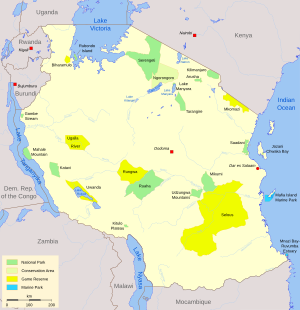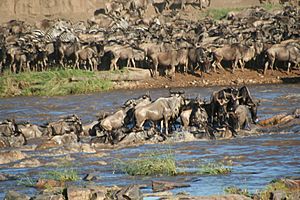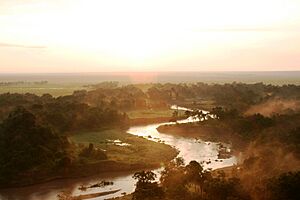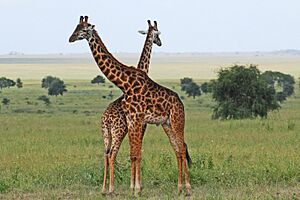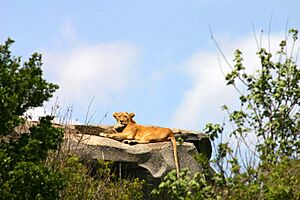Serengeti facts for kids
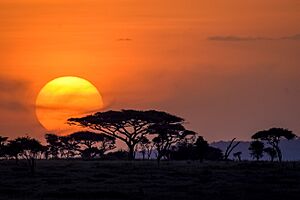
The Serengeti (say: SERR-ən-GHET-ee) is a very famous natural area in Africa. It is found in parts of Tanzania. This huge protected region is about 30,000 square kilometers (11,583 sq mi). It includes the Serengeti National Park and several game reserves. The Serengeti is known for one of the world's largest animal migrations. This amazing event makes it one of the Seven Natural Wonders of Africa.
The Serengeti is also famous for its many lions. It is one of the best places to see lion families living freely. About 70 types of large mammals and 500 bird species live here. This wide variety of animals is due to different habitats. These include river forests, swamps, rocky hills called kopjes, grasslands, and woodlands. Some common large mammals you might see are blue wildebeest, gazelles, zebras, and buffalos. The name "Serengeti" comes from the Maasai word "seringit." This word means "endless plains."
Contents
Serengeti's Past: A Journey Through Time
For a very long time, wild animals roamed freely across the huge plains of the Serengeti. Few humans lived there. This changed when the nomadic Maasai began moving into the area in the early 1800s.
The Maasai faced tough times with illnesses and dry weather. Many died from diseases in the late 1800s. Their cattle also suffered from a serious animal sickness called Rinderpest. Later, the Tanzanian government helped the Maasai settle near the Ngorongoro Crater. At this time, there was also less Poaching and fewer human-caused fires. This allowed thick forests and bushes to grow over the next 30 to 50 years. Then, Tsetse fly populations grew. This made it hard for people to live in the area.
By the mid-1970s, the numbers of wildebeest and Cape buffalo had grown back. They ate a lot of grass. This meant there was less fuel for fires. Fewer intense fires helped acacia trees grow again.
In the 21st century, programs to vaccinate pet dogs against rabies have helped. These programs have saved human lives. They have also protected wild animals like the endangered African wild dog.
The Great Migration: A Natural Wonder
Since the 1970s, a huge circular migration of blue wildebeest happens every year. It starts around January to March in the Ngorongoro Conservation Area in southern Tanzania. The herds then move clockwise through the Serengeti National Park. They continue north towards the Masai Mara reserve in Kenya. This migration happens because the animals are always looking for fresh grass to eat.
The migration begins with the calving season. This is when there is plenty of rain-soaked grass. About 260,000 zebras lead the way. They are followed by 1.7 million wildebeest. Hundreds of thousands of other plains animals, including about 470,000 gazelles, come next.
In February, the wildebeest are on the short grass plains in the southeast. They graze and give birth to around 500,000 calves in just 2 to 3 weeks. Very few calves born too early survive. This is because young calves are easier for predators to spot among older calves. As the rains stop in May, the animals start moving northwest. They head towards the areas around the Grumeti River. They usually stay there until late June. The river crossings, especially the Grumeti and Mara rivers starting in July, are a popular sight. Crocodiles wait in the rivers for the herds.
The herds reach Kenya in late July or August. They stay there for the rest of the dry season. However, Thomson's and Grant's gazelles only move east or west. In early November, when the short rains begin, the migration starts moving south again. They return to the short grass plains of the southeast. They usually arrive in December, just in time for the next calving season in February.
About 250,000 wildebeest die during their 800-kilometer (500 mi) journey. They often die from thirst, hunger, tiredness, or being hunted. Big cats are among their predators.
Serengeti's Amazing Wildlife
The Serengeti has some of East Africa's best wildlife viewing areas. Besides the great migration, it is known for its many large predators. The ecosystem is home to over 3,000 lions, 1,000 African leopards, and 7,700 to 8,700 spotted hyenas. The East African cheetah also lives in the Serengeti.
African wild dogs are not very common in much of the Serengeti. This is especially true in places like Serengeti National Park. They disappeared from there in 1992. This is because lions and spotted hyenas are common there. These predators steal food from wild dogs and can even kill them.
The Serengeti also has many different types of grazing animals. These include Cape buffalo, African elephant, warthog, Grant's gazelle, eland, waterbuck, and topi. The Serengeti can support so many different grazers because each species eats something different. For example, wildebeests like to eat shorter grasses. Plains zebras prefer taller grasses. Similarly, dik-diks eat the lowest leaves of a tree. Impalas eat leaves that are higher up. And giraffes eat leaves that are even higher.
The governments of Tanzania and Kenya protect over 80 percent of the Serengeti. They do this through national parks, conservation areas, and game reserves. Even with this protection, the ecosystem is now only about 60 percent of its original size. This is due to human activity.
The Serengeti's height above sea level ranges from 920 to 1,850 meters (3,018 to 6,070 ft). Average temperatures are usually between 15 to 25 degrees Celsius (59 to 77 degrees Fahrenheit). The climate is generally warm and dry. However, there are two rainy seasons: March to May, and a shorter one in October and November. Rainfall varies from a low of 508 mm (20 in) near the Ngorongoro highlands. It can be as high as 1,200 mm (47 in) on the shores of Lake Victoria.
The area is also home to the Ngorongoro Conservation Area. This area includes the Ngorongoro Crater and the Olduvai Gorge. Some of the oldest hominin (early human ancestors) fossils have been found there.
See also
 In Spanish: Parque nacional Serengueti para niños
In Spanish: Parque nacional Serengueti para niños
- List of topics related to Africa
- Maasai mythology


